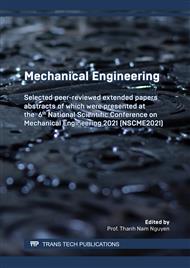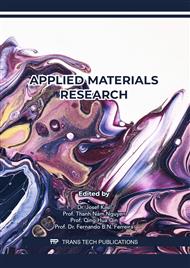[1]
W. L. Shang, et al., Quantitive variation of flavonoids in Houttuynia cordata from different geographic origins in China,, Chinese Journal of Natural Medicines (2009). Vol. 7, pp.40-46.
DOI: 10.3724/sp.j.1009.2009.00040
Google Scholar
[2]
X. Xu, et al., Determination of flavonoids in houttuynia cordata thumb and saururus chinensis (Lour.) Bail. by capillary electrophoresis with electrochemical detection,, Talanta (2006). Vol. 68, pp.759-764.
DOI: 10.1016/j.talanta.2005.05.027
Google Scholar
[3]
Y. Zhang, et al., Pressurized liquid extraction of flavonoids from Houttuynia cordata thumb,, Separation and Purification Technology (2008), Vol. 58, pp.305-310.
DOI: 10.1016/j.seppur.2007.04.010
Google Scholar
[4]
R. H. Kwon and J. Ha, Increased flavonoid compounds from fermented Houttuynia cordata using isolated six of bacillus from traditionally fermented houttuynia cordata,, Official Journal of Korean Society of Toxicology(2012), Vol. 2, pp.117-122.
DOI: 10.5487/tr.2012.28.2.117
Google Scholar
[5]
S.Y. Liao, et al., Macroporous resin adsorption for purification of flavonoids in Houttuynia cordata thunb,, Chin. J. Chem. Eng., (2007), Vol. 15, pp.872-876.
DOI: 10.1016/s1004-9541(08)60017-8
Google Scholar
[6]
L. J. Ling, et al., Flavonoids from Houttuynia cordata attenuate H1N1-inducee acute lung injury in mice via inhibition of influenza virus and toll-like receptor signalling,, Phytomedicine (2020), Vol. 67, 153159.
DOI: 10.1016/j.phymed.2019.153150
Google Scholar
[7]
S.Y. Liao, et al., Flavonoid extract from houttuynia cordata thunb induces lung cancer cell apoptosis through cell cycle arrest at S and G2 phases,, Int. Proceedings of chemical, Biological and Environmental engineering (2016). Vol. 99, pp.93-100.
Google Scholar
[8]
Y. Lu, et al., Beneficial effects of Houttuynia cordata polysaccharides on "two-hit" acute lung injury and endotoxic fever in rats associated with anti-complementary activities,, Acta Pharmaceutica Sinica B (2018). Vol. 8, pp.218-227.
DOI: 10.1016/j.apsb.2017.11.003
Google Scholar
[9]
K. H. Lee and O. J. Kim, Investigation on drying performance and energy savings of the batch-type heat pump dryer,, Drying Technology (2009). Vol. 27, pp.565-573.
DOI: 10.1080/07373930802715708
Google Scholar
[10]
Y. Wang, et al, Comparative study on the flavonoids extraction rate and antioxidant activity of onions treated by three different drying methods,, Drying Technology (2019). Vol. 37, pp.1-8.
DOI: 10.1080/07373937.2018.1482907
Google Scholar
[11]
L. Stawreberg and L. Nilsson, Modelling of specific moisture extraction rate and leakage ratio in a condensing tumble dryer,, Applied Thermal Engineering (2010). Vol. 30, pp.2173-2179.
DOI: 10.1016/j.applthermaleng.2010.05.030
Google Scholar
[12]
A. Singh, et al, Energetic and exergetic performance simulation of open-type heat pump dryer with next-generation refrigerants,, Drying Technology (2020). Vol. 38, pp.1011-1023.
DOI: 10.1080/07373937.2019.1610770
Google Scholar
[13]
P. Saensabai and S. Prasertsan, Effects of component arrangement and ambient and drying conditions on the performance of heat pump dryers,, Drying Technology (2003). Vol. 21, pp.103-127.
DOI: 10.1081/drt-120017286
Google Scholar
[14]
K. H. Lee, et al, Performance simulation of a two-cycle heat pump dryer for high-temperature drying,, Drying Technology (2010). Vol. 28, pp.683-689.
DOI: 10.1080/07373931003799210
Google Scholar
[15]
A. Saensabai and S. Prasertsan, Condenser coil optimization and component matching of heat pump dryer,, Drying Technology (2007). Vol. 25, pp.1571-1580.
DOI: 10.1080/07373930701370084
Google Scholar
[16]
T.T.Q. Anh, et al, Effect of some specifications on quality of fish mint tea bags,, Huaf Journal Agricultural Science & Technology (2019). Vol. 3, pp.1199-1208.
Google Scholar
[17]
A. S. Mujumdar, Handbook of industrial drying,, Fourth Edition; Taylor & Francis Group, LLC, (2015).
Google Scholar
[18]
S. Abasi and S. Minaei, Effect of drying temperature on mechanical properties of dried corn,, Drying Technology (2014). Vol. 32, pp.774-780.
DOI: 10.1080/07373937.2013.845203
Google Scholar
[19]
S. Jeyaprakash, et al, Influence of heat pump drying on tomato flavor,, Drying Technology (2016). Vol. 34, pp.1709-1718.
DOI: 10.1080/07373937.2016.1174937
Google Scholar
[20]
K. J. Chua, et al, On the study of time-varying temperature drying-effect on drying kinetics and product quality,, Drying Technology (2002). Vol. 20, pp.1559-1577.
DOI: 10.1081/drt-120014052
Google Scholar
[21]
U. S. Pal and M. K. Khan, Performance evaluation of heat pump dryer,, J Food Sci Technology (2010). Vol. 47, pp.230-234.
DOI: 10.1007/s13197-010-0031-3
Google Scholar
[22]
X. D. Song, et al, Effect of drying air temperature on drying kinetics, color, carotenoid content, antioxidant capacity and oxidation of fat for lotus pollen,, Drying Technology (2020). Vol. 38, pp.1151-1164.
DOI: 10.1080/07373937.2019.1616752
Google Scholar
[23]
K. H. Lee and O. J. Kim, Investigation on drying performance and energy savings of the batch-type heat pump dryer,, Drying Technology (2009). Vol. 27, pp.565-573.
DOI: 10.1080/07373930802715708
Google Scholar
[24]
N. A. Poirier and I. I. Pikulik, The effect of drying temperature on the quality of paper,, Drying Technology (1997). Vol. 15, pp.1869-1879.
DOI: 10.1080/07373939708917333
Google Scholar



